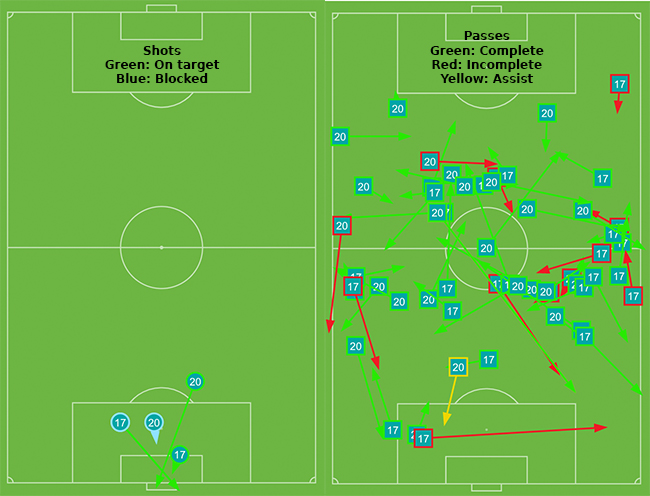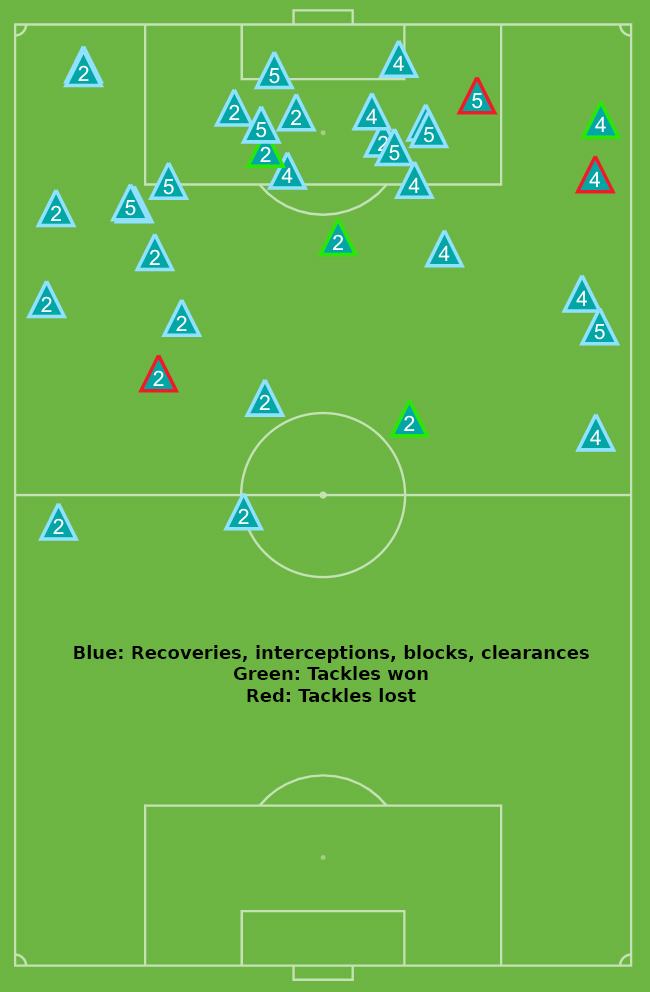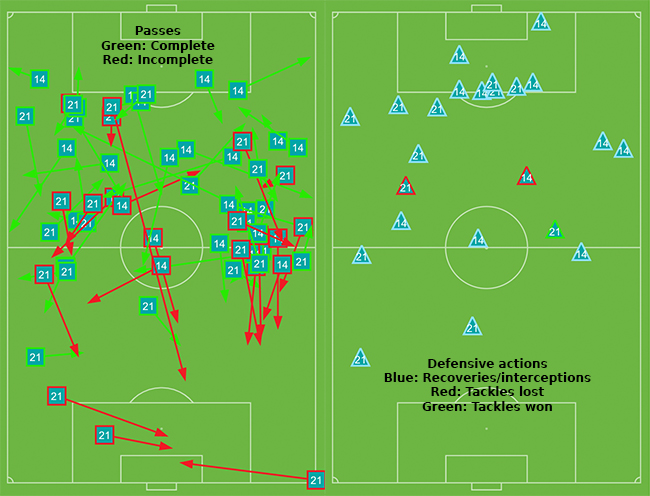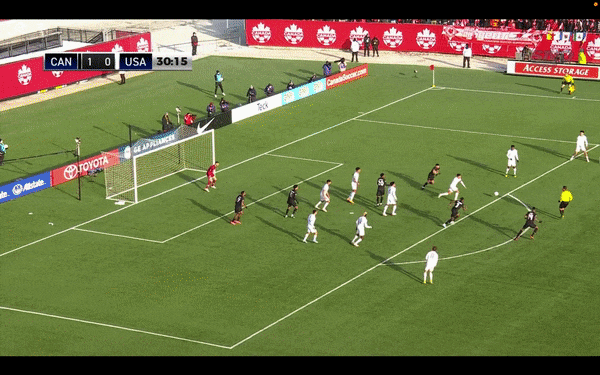
The Canadian men’s national team can’t be beaten.
The latest triumph, a 2-0 win over the United States in World Cup qualifying at Tim Hortons Field in Hamilton on Sunday, might be the crowning moment.
Les Rouges had already taken four of six points from Mexico, exorcised the demons in Honduras and Haiti, reached the Gold Cup semifinals for the first time since 2007 and proved they can overcome and manage adversity.
All that remained was to end a 42-year drought and defeat the U.S. in a World Cup qualifier. You can punch another hole in that rewards card.
It’s worth remembering that no one is supposed to maintain this level of consistency in Concacaf. It exists to trip up teams and test their mental resolve. Even Mexico and the U.S. experience the odd slip-up.
Not Canada, though. At least, not yet.
Here are three takeaways from another historic day for Canadian soccer:
The David-Larin connection reignites
Cyle Larin was on the fringes of the national team radar in 2019. He started against Mexico in Canada’s group-stage finale at the Gold Cup that same year, but he looked off the pace in many regards.
A few months later, the former MLS rookie of the year was struggling to earn regular minutes at Besiktas and was sent on loan to Zulte Waregem in Belgium. He showed major improvements as a second striker before returning to Turkey. After receiving a few starts as a striker to begin the 2020-21 season, he was eventually moved to an inside-forward role on the left wing.
Following that positional shift, Larin scored 20 goals in 39 games, helping Besiktas win the Turkish Super Lig. Despite playing on the left, he highlighted a lot of similar traits from his time in Belgium, and that is a testament to former Besiktas coach Sergen Yalcin for recognizing those strengths.
But that clearly rejuvenated Larin. His family finally joined him in Istanbul, he was starting every week for a marquee European club, won a league title and that confidence translated to the national team to begin 2021.
Fifteen goals, 15 games and about 10 months later, Larin now stands alone as the Canadian men’s national team’s all-time leading scorer.
The record-breaking goal might prove one of the most significant in the program’s history. It was a microcosm of Canada’s newfound tactical identity of being able to play a fluid style.
It was a perfect combination. Larin found Jonathan David, the former darted into the open space between the American centre-backs, the latter read the situation immediately, played in Larin and he did the rest.
The partnership has come under scrutiny due to their similar characteristics. Both players enjoy shadowing into the box, executing late runs and dropping deep. But they thrived together in June. They were pretty effective against Honduras in September as well, registering a combined 1.14 expected goals (xG) in that game.
Keep in mind, before the Honduras victory on Thursday, Larin and David hadn’t started together since the September draw with the Hondurans. Without Alphonso Davies, it gave the connection a chance to reignite.
“In transition you have seen it, they have been lethal,” said Canada coach John Herdman. “They have started to build that understanding of, and predicting where, they are going to be. I think you are starting to see that reaction time close where they just know. They know where they are going to be as they get on the half turn.”
Despite Canada’s lack of possession and lower shot count (eight compared to the Americans’ 13), Larin and David had a pretty effective match, all things considered. They combined to attempt four shots, with a combined xG of 0.89, and were effective at spreading the ball around.

All in a day’s work for Canada’s dynamic duo.
Borjan, Canadian defence stands tall
On his father’s birthday, in the city he grew up in, Milan Borjan gifted the ultimate present.
In the end, Borjan needed to make only three saves despite the U.S. outshooting Canada 13-8, but that proved decisive. Just like the two stops in Honduras three days ago, or the other two against Mexico in November.
“He’s just come up huge for us time and time again,” said midfielder Jonathan Osorio. “I have no words for the performances that he has been putting out there for us, making these huge, huge saves for us in big, big moments.
“We trust him and we expect that from him because we know how good he is. We know going into games that he is going to have to save us a couple of times, maybe, in games and he does. He is ready for the moment every time.”
Davies, David, Larin and Tajon Buchanan may receive the plaudits in most games, but Borjan is just as key.
A hat tip to the back three of Alistair Johnston, Steven Vitoria and Kamal Miller as well, who completed a combined 12 clearances, nine recoveries, three blocks, four interceptions and won four of their seven tackles.

Midfield inferiority
The big story before the game surrounded midfield maestro Stephen Eustaquio’s status. Having tested positive for COVID-19 last week, he was in doubt for these three qualifiers but remained day-to-day after he was named to the final roster.
He ended up arriving in Hamilton and was even named among the substitutes when Canada Soccer announced the lineup right before 2 p.m. ET. Eustaquio warmed up but then headed down the tunnel before the rest of the Canadian players.
Eventually, he was omitted from the final teamsheet, as was Atiba Hutchinson, so there were only four available midfielders.
Two of them, Osorio and Mark-Anthony Kaye, started in a double pivot but neither has played a competitive match since November, at the latest. With the U.S. trio of Tyler Adams, Weston McKennie and Yunus Musah in mid-season form, it was going to be a challenge for the MLS duo.
Neither player looked particularly comfortable on the ball. They weren’t hitting passes with the right weight and continually coughed up possession when the U.S. pressed them high up the pitch. Those are likely symptoms of a lack of competitive matches.
To their credit, they remained defensively committed and made crucial interventions when needed.

“It was not a tactical issue for me in terms of matching (U.S. coach) Gregg (Berhalter’s) structures,” said Herdman. “It was more about the individual quality of Musah and McKennie.
“It was about being in control, getting more zonal, so we always had another cover or support within five or 10 yards of McKennie so whenever pressure went on, there was cover to him.”
Kaye was eventually replaced by Liam Fraser and Junior Hoilett eventually checked in for added support. Hoilett reminded fans why he was a regular starter before his injuries in October. The ability to maneuver through tight spaces and progress the ball cannot be underestimated.
JUNIOR HOILETT pic.twitter.com/OjdWUBahbn
— CBS Sports Golazo (@CBSSportsGolazo) January 30, 2022
But with Kaye and Osorio on the pitch, the U.S. midfield had promising opportunities in transition. Luckily for Canada, tactical fouls came in handy. Even before Vitoria commits to the tackle in the clip below, it’s obvious that the Canadian players are trying to foul the Americans.

“I think you have to (tactically foul) at this level,” said Herdman. “I think that transitional moment is just so critical and those smart fouls are something we talk about. It is an important part of our game.”
With the referee letting the game flow, Canada racked up only 12 fouls and it could’ve been more, not that the players will complain.




